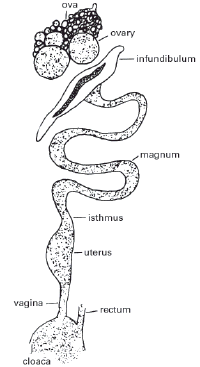
Formation of the egg
 |
Reproductive organs of the hen |
The egg is formed gradually over a period of about 25 hours. Many organs and systems help to convert raw materials from the food eaten by the hen into the various substances that become part of the egg.
The ovary
The hen, unlike most animals, has only one functional ovary - the left one - situated in the body cavity near the backbone. At the time of hatching, the female chick has up to 4000 tiny ova (reproductive cells), from some of which full-sized yolks may develop when the hen matures. Each yolk (ovum) is enclosed in a thin-walled sac, or follicle, attached to the ovary. This sac is richly supplied with blood.
The oviduct
The mature yolk is released when the sac ruptures, and is received by the funnel of the left oviduct (the right oviduct is not functional). The left oviduct is a coiled or folded tube about 80 cm in length. It is divided into five distinct sections, each with a specific function, as summarised in table 1.
Table 1: Functions of various different sections of the hen's oviduct
| Section of oviduct | Approximate time egg spends in this section | Functions of section of oviduct |
|---|---|---|
| 1 Funnel (infundibulum) | 15 minutes | Receives yolk from ovary. If live sperm present, fertilisation occurs here (commercially produced table eggs are not fertilised) |
| 2 Magnum | 3 hours | Albumen (white) is secreted and layered around |
| 3 Isthmus | 1 hour | Inner and outer shell membranes are added, as are some water and mineral salts |
| 4 Shell gland (uterus) | 21 hours | Initially some water is added, making the outer white thinner. Then the shell material (mainly calcium carbonate) is added. Pigments may also be added to make the shell brown |
| 5 Vagina/cloaca | less than 1 minute | The egg passes through this section before laying. It has no other known function in the egg’s formation |
© The State of Queensland, Australia (through its Department of Primary Industries and Fisheries) and DSM Nutritional Products Ltd., 2007. No part of this publication may be reproduced, copied or transmitted save with prior written permission of Director, Intellectual Property Commercialisation Unit, Department of Primary Industries and Fisheries, GPO Box 46 Brisbane, Queensland, Australia 4001, and DSM Nutritional Products Ltd.






